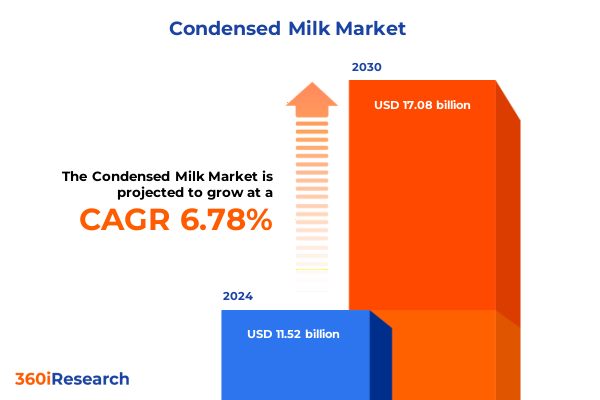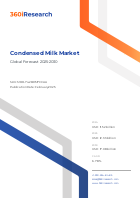The Condensed Milk Market size was estimated at USD 11.52 billion in 2024 and expected to reach USD 12.33 billion in 2025, at a CAGR 6.78% to reach USD 17.08 billion by 2030.

Introduction
The global condensed milk sector has evolved from a niche pantry staple into a dynamic market driven by shifting consumer preferences and strategic industry initiatives. Once primarily valued for its long shelf life and functionality in baking and confectionery, condensed milk now finds new audiences exploring innovative flavors, healthier formulations, and premium packaging. Growing interest in specialty diets, coupled with rising demand for on-the-go indulgences, has prompted manufacturers to reassess traditional approaches and introduce product lines that resonate with modern lifestyles.
Against this backdrop, stakeholders are reimagining supply chains, forging partnerships across the value chain, and leveraging technological advances to maintain quality while streamlining distribution. As regulatory landscapes adapt-particularly in key export markets-producers and distributors must navigate evolving tariffs and compliance requirements. In this context, a comprehensive understanding of market drivers, segmentation dynamics, and regional nuances is essential for companies aiming to sustain competitive advantage and capitalize on emerging opportunities.
Transformative Shifts in the Landscape
Over the past decade, the condensed milk landscape has undergone transformative shifts that have redefined competitive boundaries. On the product front, innovative flavor extensions like matcha, salted caramel, and exotic fruit infusions have captured consumer curiosity and created premium positioning for established brands. Simultaneously, the surge in clean-label and organic trends has motivated manufacturers to reformulate offerings, reducing sugar content and sourcing responsibly produced ingredients.
Packaging has also seen a revolution: resealable squeeze bottles and single-serve Tetra Packs now cater to convenience-oriented lifestyles, while glass jars appeal to craft-oriented segments. Behind the scenes, digital supply-chain platforms are optimizing traceability, reducing waste, and enabling real-time quality monitoring. Furthermore, collaborations between dairy producers and foodservice operators have yielded co-branded desserts and specialty beverages, driving demand across cafes, restaurants, and catering services.
These shifts underscore a broader industry trend toward personalization and sustainability, where brands integrate environmental commitments with product innovation. As a result, players are leveraging data analytics to anticipate consumer trends, aligning R&D investments with health and wellness imperatives.
Cumulative Impact of United States Tariffs 2025
In 2025, revised U.S. trade policies introduced tariffs that significantly impacted condensed milk imports and exports. Suppliers accustomed to exporting high-volume steel-packaged cans faced increased duty costs, prompting many to reassess their entry strategies into North American markets. As a ripple effect, domestic producers leveraged the opportunity to expand shelf space, positioning locally manufactured sweetened condensed milk as a competitive alternative.
To mitigate tariff pressure, several international exporters transitioned to alternative packaging formats-such as aluminum cans and Tetra Packs-that fall under more favorable tariff classifications. Meanwhile, value-added offerings like flavored condensed milk gained traction as importers prioritized differentiated products capable of justifying higher price points. Retailers, responding to consumer sensitivity to price fluctuations, intensified promotional activities and adjusted private-label rollouts to maintain affordability.
On the supply side, manufacturers optimized production footprints, relocating certain high-volume lines closer to consumption centers to reduce cross-border duties. Looking ahead, industry alliances will likely play a pivotal role in advocating for tariff adjustments and facilitating knowledge-sharing around cost-effective logistics solutions.
Key Segmentation Insights
Analysis across product type reveals three core categories: flavored condensed milk-featuring variants in caramel, chocolate, strawberry, and vanilla-regular sweetened condensed milk offered in full-cream, organic, skimmed, and low-fat full-cream formulations, and unsweetened condensed milk available in full-cream, organic, and skimmed options. This granular view highlights distinct consumption patterns, with flavored offerings driving indulgence segments, while organic formulations capture health-conscious shoppers.
In terms of packaging type, consumers now choose between cans crafted from aluminum or steel, glass jars that evoke artisanal appeal, convenient squeeze bottles for on-the-go usage, and Tetra Packs that marry portability with extended shelf life. Each format aligns with specific distribution channels, from large-format retail to foodservice outlets.
Application analysis underscores that bakery applications-including bread, cakes, cookies, and pastries-remain fundamental, while beverages such as cocktails, coffee blends, milkshakes, and specialty teas showcase condensed milk’s versatility. Confectionery uses extend beyond candies to include caramel fillings and fudges, and dessert applications span custards, ice creams, and puddings, generating cross-category demand.
Examining end-users, the foodservice industry-comprising cafés, catering services, hotels, and restaurants-drives bulk consumption, while industrial users, particularly confectionery and food manufacturers, integrate condensed milk into ingredient formulations. Retail consumers, primarily households, fuel smaller-package demand at supermarkets and e-commerce channels.
Lastly, dietary needs have fostered segments in gluten-free, lactose-free, and vegan formulations, enabling the market to address allergen concerns and ethical consumption trends. Together, these segmentation insights provide a roadmap for tailored product development and channel strategies.
This comprehensive research report categorizes the Condensed Milk market into clearly defined segments, providing a detailed analysis of emerging trends and precise revenue forecasts to support strategic decision-making.
- Product Type
- Packaging Type
- Application
- End-User
- Dietary Needs
Key Regional Insights
Regionally, the Americas maintain their lead in per-capita consumption, driven by established baking traditions and strong retail distribution networks. North America, in particular, exhibits robust demand for flavored and reduced-sugar variants, while Latin American markets continue to rely on traditional full-cream sweetened condensed milk, supported by deep-rooted culinary customs.
In Europe, Middle East & Africa, diverse regulatory environments shape product innovation. Western Europe emphasizes clean-label initiatives and organic sourcing, while Eastern Europe presents opportunities for cost-competitive milk products. In the Middle East, rising café culture has spurred flavored condensates for regional beverages, and Africa’s expanding urban population is creating new entry points for sachet and Tetra Pack solutions.
Asia-Pacific is experiencing the fastest expansion in premium and specialty segments. Southeast Asian nations embrace novel flavor fusions and plant-based alternatives, while East Asia’s large coffee shop networks demand high-quality sweetened condensed milk for signature beverages. Australia and New Zealand leverage strong dairy industries to supply both local and export markets, reinforcing the region’s strategic importance.
This comprehensive research report examines key regions that drive the evolution of the Condensed Milk market, offering deep insights into regional trends, growth factors, and industry developments that are influencing market performance.
- Americas
- Asia-Pacific
- Europe, Middle East & Africa
Key Companies Insights
The competitive landscape features legacy dairy cooperatives and multinational conglomerates. Alaska Milk Corporation has differentiated through functional innovations and localized flavors, while Arla Foods Group leverages its cooperative model to champion organic variants. Belgorod Dairy Products OJSC capitalizes on cost efficiencies in Eastern Europe, and Dana Dairy focuses on premium packaging and halal certifications to access Middle Eastern markets.
Dutch Lady Malaysia and Fraser & Neave Holdings Bhd have jointly expanded distribution in Southeast Asia, integrating Tetra Pack lines for enhanced shelf stability. Eagle Family Foods Group LLC has reinforced its U.S. presence with flavored condensates tailored to foodservice chains, whereas F&N Foods Pte Ltd. emphasizes R&D partnerships to pioneer low-sugar formulations.
Galloway Company and Goya Foods, Inc. exploit strong brand recognition in specialty ethnic segments, while Gujarat Cooperative Milk Marketing Federation Ltd. (Amul) maintains volume leadership in South Asia through comprehensive retail outreach. Hochwald Foods GmbH by Hochwald Milch eG and O-AT-KA Milk Products emphasize efficiency in processed cheese and milk lines alongside condensed milk portfolios.
Nestlé S.A., Santini Foods, Inc., The J.M. Smucker Company, and Vinamilk complete the roster of key players, each deploying unique strategies from cross-category bundling to strategic acquisitions. Together, these companies illustrate a blend of innovation, scale, and regional expertise that shapes competitive dynamics.
This comprehensive research report delivers an in-depth overview of the principal market players in the Condensed Milk market, evaluating their market share, strategic initiatives, and competitive positioning to illuminate the factors shaping the competitive landscape.
- Alaska Milk Corporation
- Arla Foods Group
- Belgorod Dairy Products OJSC
- Dana Dairy
- Dutch Lady Malaysia
- Eagle Family Foods Group LLC
- F&N Foods Pte Ltd.
- Fraser & Neave Holdings Bhd
- Galloway Company
- Goya Foods, Inc.
- Gujarat Cooperative Milk Marketing Federation Ltd.
- Hochwald Foods GmbH by Hochwald Milch eG
- Nestlé S.A.
- O-AT-KA Milk Products
- Santini Foods, Inc.
- The J.M. Smucker Company
- Vinamilk
Actionable Recommendations for Industry Leaders
Industry leaders should prioritize a triad of strategic initiatives: first, accelerate product innovation by developing clean-label, reduced-sugar, and plant-based formulations that resonate with health-focused consumers; second, optimize supply chains through regional production hubs and digital traceability systems to mitigate trade-related cost pressures and ensure consistency in quality; third, strengthen channel partnerships by co-creating exclusive product lines with foodservice operators and retailers, enhancing brand visibility and consumer loyalty.
Concurrently, executives must invest in market intelligence tools to monitor evolving regulatory frameworks and tariff developments, enabling agile pricing and sourcing decisions. Embracing circular packaging solutions and carbon-neutral commitments will further differentiate brands in sustainability-conscious markets. Finally, cultivating direct-to-consumer channels-leveraging e-commerce platforms and subscription models-will unlock new growth vectors while deepening customer relationships and data insights.
Explore AI-driven insights for the Condensed Milk market with ResearchAI on our online platform, providing deeper, data-backed market analysis.
Ask ResearchAI anything
World's First Innovative Al for Market Research
Conclusion
The condensed milk market stands at the intersection of tradition and innovation. By understanding nuanced consumer segments, navigating tariff landscapes, and leveraging regional strengths, stakeholders can shape resilient growth strategies. Companies that harmonize operational excellence with bold product differentiation will secure long-term market leadership. As the sector continues to evolve, proactive collaboration across value chains and relentless focus on consumer priorities will remain the cornerstone of sustainable success.
This section provides a structured overview of the report, outlining key chapters and topics covered for easy reference in our Condensed Milk market comprehensive research report.
- Preface
- Research Methodology
- Executive Summary
- Market Overview
- Market Dynamics
- Market Insights
- Cumulative Impact of United States Tariffs 2025
- Condensed Milk Market, by Product Type
- Condensed Milk Market, by Packaging Type
- Condensed Milk Market, by Application
- Condensed Milk Market, by End-User
- Condensed Milk Market, by Dietary Needs
- Americas Condensed Milk Market
- Asia-Pacific Condensed Milk Market
- Europe, Middle East & Africa Condensed Milk Market
- Competitive Landscape
- ResearchAI
- ResearchStatistics
- ResearchContacts
- ResearchArticles
- Appendix
- List of Figures [Total: 26]
- List of Tables [Total: 776 ]
Call-To-Action
To explore deeper insights and tailored strategies for your organization, reach out to Ketan Rohom (Associate Director, Sales & Marketing). He can guide you through the complete market research report and help you identify the opportunities most relevant to your business objectives. Contact Ketan today to unlock the full potential of the condensed milk market.

- How big is the Condensed Milk Market?
- What is the Condensed Milk Market growth?
- When do I get the report?
- In what format does this report get delivered to me?
- How long has 360iResearch been around?
- What if I have a question about your reports?
- Can I share this report with my team?
- Can I use your research in my presentation?




